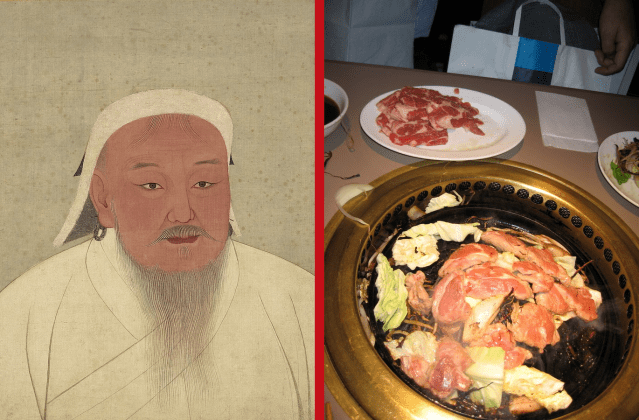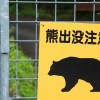
Mutton dish is commonly known by name of Mongolian historical figure instead of its original name.
So imagine you’re in Japan and hungry. You’re in luck, because the country’s restaurants offer plenty of filling food options to choose from, like curry rice, tempura, tonkatsu, and Genghis Khan.
What’s that? You’re saying that one of those isn’t a food, but actually the ruler of the Mongolian Empire during the late 12th and early 13th centuries? Well, of course, that’s true too. In Japan, though, “Genghis Khan” does double duty as both the name of the famous military commander and the meaty dish seen below.
松尾ジンギスカン 札幌駅前店に来た
— たくや (@mashataku) August 20, 2019
今混んでるので90分コースが値段一緒で60分になるとの事😓
良い商売してるよね
最初のセットで時間来るの悔しいので、特上お代わりしてやった😁
5300円も払うんだったら、ふつうに天壇で焼き肉食べた方が良いもん食べれるかも
あ、酔っぱらいの独り言です😁 pic.twitter.com/JLTGpGbSSa
Japan’s closest equivalent to the type of cuisine called “Mongolian barbecue” in the U.S., the key ingredient in the dish called Genghis Khan are strips of mutton, grilled on a dome-shaped metal plate and surrounded by bean sprouts and sliced onions. It’s particularly popular on Japan’s northern island of Hokkaido, but also pretty easy to find across Japan.
ジンギスカン食べてます!
— ばんきん番長ひつじちゃん@辻製作所 (@tsujiss1960) August 17, 2019
(そんたくん) pic.twitter.com/HR92GYJ6It
However, Haiying Yang, a Mongolian-born humanities professor at Japan’s Shizuoka University, takes issue with the dish’s name. “Mongolian people feel the same way about Genghis Khan as Japanese people feel about the emperor of Japan,” Yang told the Japanese-language division of Newsweek. “He is a sacred figure whose name should not be used for a kind of food.”
Yang likened the naming convention to American media personality Kim Kardashian’s recent plan to create a new bodywear line to be called “Kimono Solutionwear.” “When a foreign lingerie maker, or a clothing company or something, was going to use the word ‘kimono,’ it struck a nerve with people in Japan and caused a large reaction,” Yang said in discussing the dish called Genghis Khan. He also claims that the issue has been a sore spot with Mongolian residents, especially in the late 1980s and 1990s.
ジンギスカン!!!!✨✨
— みぞれ❄️ (@mimizoreyuki) August 17, 2019
美味しい!😋😋 pic.twitter.com/6jglbuqSA0
But how did Genghis Khan’s name become associated with the dish in the first place? According to Japanese food historian Keiichi Takaishi, it all goes back to Yoshiji Washizawa, a Japanese journalist born in 1883 who spent part of his life living and working in Beijing. While there, he and a Japanese coworker ate a mutton dish at a restaurant, and recalled also eating it in Mongolia. They began referring to the dish as “Genghis Khan” when talking with each other, and eventually, Takaishi says, the term caught on among other Japanese people living in China, and eventually spread back to Japan.
It’s worth pointing out, however, that the Japanese-language pronunciation and way of writing for the two “Genghis Khans” is slightly different:
● ジンギスカン / jingisukan = food
● チンギスハン / chingisuhan = historical figure
So what’s the Chinese name for the dish Washizawa and his friend ate? Kaoyangrou, and it actually seems to be more associated with Xian than Mongolia.
▼ Kaoyangrou
空气炸锅烤羊肉,要是再多点肥肉就完美了 pic.twitter.com/TqBNa4X1BU
— 一颗苹果 (@bronzitte) December 4, 2018
Yang’s assertion that Genghis Khan occupies the same place in Mongolian people’s hearts and minds as the emperor of Japan does for Japanese people isn’t the most air-tight analogy, as at any given moment Japan has a current emperor, and attaching the name of someone who’s currently alive and walking around to something you’re about to eat would be surreal in a different way. Still, considering that you don’t go into a restaurant in Japan and order a “Julius Caesar” or “George Washington” when you want a pizza or hamburger, it’s a little odd that “Genghis Khan” calls up as many images of meat as it does history in Japan.
Source: Abema Times via Hachima Kiko, Things Asian, Crawford Creations
Top image: Wikipedia/HuangdiOfSongChina, Wikipedia/Jrballe (edited by SoraNews24)
● Want to hear about SoraNews24’s latest articles as soon as they’re published? Follow us on Facebook and Twitter!
Follow Casey on Twitter, where he knew about Shirley Temple the drink long before Shirley Temple the actress.

 Genghis Khan-insulting manga pulled from major book stores amid further Mongolian protests
Genghis Khan-insulting manga pulled from major book stores amid further Mongolian protests “Hey, Japanese taxi driver, take us to the best Sapporo ramen place!” – Things don’t go as planned
“Hey, Japanese taxi driver, take us to the best Sapporo ramen place!” – Things don’t go as planned The long road of the Chusonji Lotus spans nearly a millennium of Japanese history
The long road of the Chusonji Lotus spans nearly a millennium of Japanese history Cats living in Tokyo sumo training facility are champions of cuteness 【Photos】
Cats living in Tokyo sumo training facility are champions of cuteness 【Photos】 U.S. military in Japan bulk buys Japanese scallops as China’s Japanese seafood ban continues
U.S. military in Japan bulk buys Japanese scallops as China’s Japanese seafood ban continues Foreigner’s request for help in Tokyo makes us sad for the state of society
Foreigner’s request for help in Tokyo makes us sad for the state of society Bad tourist manners at Mt Fuji Lawson photo spot prompts Japanese town to block view with screens
Bad tourist manners at Mt Fuji Lawson photo spot prompts Japanese town to block view with screens One of Japan’s oldest castles now lets travelers spend night on the grounds, drink in its keep
One of Japan’s oldest castles now lets travelers spend night on the grounds, drink in its keep McDonald’s Japan’s new pancake pie is a taste sensation
McDonald’s Japan’s new pancake pie is a taste sensation Studio Ghibli unveils new goods that tip the hat to The Cat Returns
Studio Ghibli unveils new goods that tip the hat to The Cat Returns Bear attacks car in Japan, breaks windshield with its paw【Video】
Bear attacks car in Japan, breaks windshield with its paw【Video】 Two things to do, and two things not to do, when leaving a traditional Japanese inn
Two things to do, and two things not to do, when leaving a traditional Japanese inn All-you-can-drink Starbucks and amazing views part of Tokyo’s new 170 meter-high sky lounge
All-you-can-drink Starbucks and amazing views part of Tokyo’s new 170 meter-high sky lounge W.T.F. Japan: The top five “sora” references of all time! 【Weird Top Five】
W.T.F. Japan: The top five “sora” references of all time! 【Weird Top Five】 FUK COFFEE?!? Japanese cafe has a perfectly innocent reason for its startling-looking name
FUK COFFEE?!? Japanese cafe has a perfectly innocent reason for its startling-looking name Japanese ramen restaurants under pressure from new yen banknotes
Japanese ramen restaurants under pressure from new yen banknotes Red light district sushi restaurant in Tokyo shows us just how wrong we were about it
Red light district sushi restaurant in Tokyo shows us just how wrong we were about it McDonald’s new Happy Meals offer up cute and practical Sanrio lifestyle goods
McDonald’s new Happy Meals offer up cute and practical Sanrio lifestyle goods Tokyo Tsukiji fish market site to be redeveloped with 50,000-seat stadium, hotel, shopping center
Tokyo Tsukiji fish market site to be redeveloped with 50,000-seat stadium, hotel, shopping center Japanese city loses residents’ personal data, which was on paper being transported on a windy day
Japanese city loses residents’ personal data, which was on paper being transported on a windy day Beautiful Red and Blue Star luxury trains set to be Japan’s new Hokkaido travel stars
Beautiful Red and Blue Star luxury trains set to be Japan’s new Hokkaido travel stars Ghibli Park now selling “Grilled Frogs” from food cart in Valley of Witches
Ghibli Park now selling “Grilled Frogs” from food cart in Valley of Witches New definition of “Japanese whiskey” goes into effect to prevent fakes from fooling overseas buyers
New definition of “Japanese whiskey” goes into effect to prevent fakes from fooling overseas buyers Our Japanese reporter visits Costco in the U.S., finds super American and very Japanese things
Our Japanese reporter visits Costco in the U.S., finds super American and very Japanese things More foreign tourists than ever before in history visited Japan last month
More foreign tourists than ever before in history visited Japan last month New Pokémon cakes let you eat your way through Pikachu and all the Eevee evolutions
New Pokémon cakes let you eat your way through Pikachu and all the Eevee evolutions Disney princesses get official manga makeovers for Manga Princess Cafe opening in Tokyo
Disney princesses get official manga makeovers for Manga Princess Cafe opening in Tokyo We try out “Chan Ramen”, an underground type of ramen popular in the ramen community
We try out “Chan Ramen”, an underground type of ramen popular in the ramen community Sales of Japan’s most convenient train ticket/shopping payment cards suspended indefinitely
Sales of Japan’s most convenient train ticket/shopping payment cards suspended indefinitely Sold-out Studio Ghibli desktop humidifiers are back so Totoro can help you through the dry season
Sold-out Studio Ghibli desktop humidifiers are back so Totoro can help you through the dry season Japanese government to make first change to romanization spelling rules since the 1950s
Japanese government to make first change to romanization spelling rules since the 1950s Ghibli founders Toshio Suzuki and Hayao Miyazaki contribute to Japanese whisky Totoro label design
Ghibli founders Toshio Suzuki and Hayao Miyazaki contribute to Japanese whisky Totoro label design Doraemon found buried at sea as scene from 1993 anime becomes real life【Photos】
Doraemon found buried at sea as scene from 1993 anime becomes real life【Photos】 Tokyo’s most famous Starbucks is closed
Tokyo’s most famous Starbucks is closed One Piece characters’ nationalities revealed, but fans have mixed opinions
One Piece characters’ nationalities revealed, but fans have mixed opinions We asked a Uniqlo employee what four things we should buy and their suggestions didn’t disappoint
We asked a Uniqlo employee what four things we should buy and their suggestions didn’t disappoint Cup Noodle vs 7-Eleven! We test their new scorching instant ramen cups to see who beats at heat
Cup Noodle vs 7-Eleven! We test their new scorching instant ramen cups to see who beats at heat Kim Kardashian drops plans to call new fashion brand Kimono Solutionwear
Kim Kardashian drops plans to call new fashion brand Kimono Solutionwear Is Ariana Grande “Asian Fishing”? Japanese netizens weigh in on the drama
Is Ariana Grande “Asian Fishing”? Japanese netizens weigh in on the drama Graphical glitches turn Pokémon Masters mobile game into mind-flaying horror story【Video】
Graphical glitches turn Pokémon Masters mobile game into mind-flaying horror story【Video】 Deadpool opening a huge success…but we wouldn’t know because we’re in Japan
Deadpool opening a huge success…but we wouldn’t know because we’re in Japan Wait…Hello Kitty has a twin sister?!?!?
Wait…Hello Kitty has a twin sister?!?!? Japanese fisherman becomes TikTok heartthrob, shares cute dance videos while working at sea
Japanese fisherman becomes TikTok heartthrob, shares cute dance videos while working at sea Japanese man expects woman to serve him at drinking party, gets helping of delicious sass instead
Japanese man expects woman to serve him at drinking party, gets helping of delicious sass instead Christian groups in Japan criticize emperor’s ascension ceremony as violation of constitution
Christian groups in Japan criticize emperor’s ascension ceremony as violation of constitution Mos Burger brings out a Mac and Cheese burger in Japan
Mos Burger brings out a Mac and Cheese burger in Japan The one-year countdown officially begins for the end of the Heisei Era
The one-year countdown officially begins for the end of the Heisei Era The Fuwatoro Yamaimo Teppan just might be 7-Eleven Japan’s dish of the year【Taste test】
The Fuwatoro Yamaimo Teppan just might be 7-Eleven Japan’s dish of the year【Taste test】 Douhua, a delicious tofu pudding, is Mr. Sato’s new favourite food
Douhua, a delicious tofu pudding, is Mr. Sato’s new favourite food Japanese convenience store pasta called “a monstrosity” by foreigners online
Japanese convenience store pasta called “a monstrosity” by foreigners online The strange part of Japan where “grilled chicken” doesn’t always mean “chicken”
The strange part of Japan where “grilled chicken” doesn’t always mean “chicken”
Leave a Reply